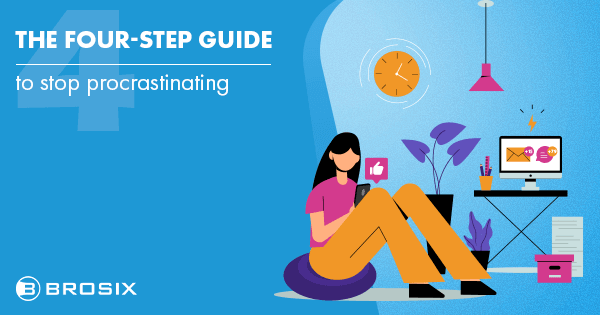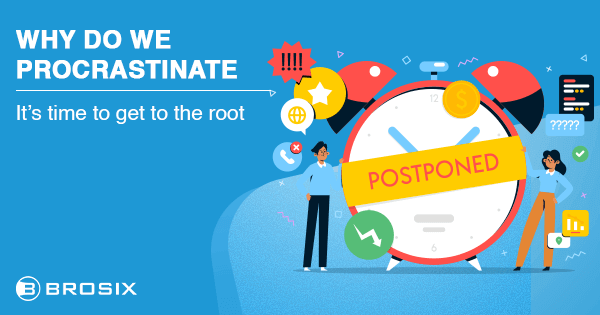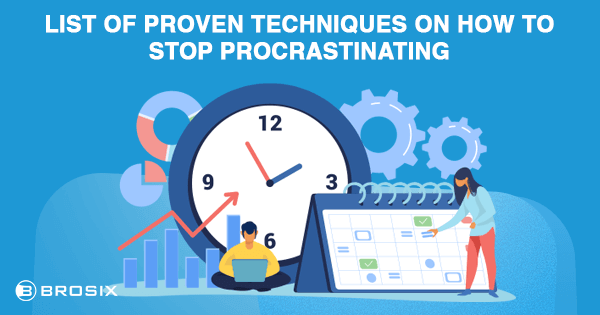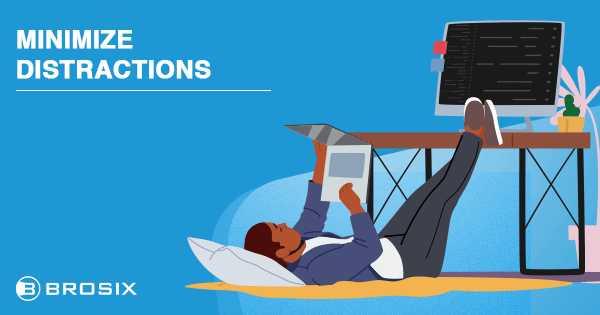Procrastination is the habit of postponing or delaying tasks, actions, or decisions for no apparent reason. It’s such a common consequence of the modern world that 20% of adults and 50% of students procrastinate severely.
There are many explanations for why people procrastinate, and most of them have to do with cognitive psychology. Anxiety or the fear of failing are some of the most common demotivators. These emotions can cause us to postpone tasks instead of completing them on time. Mental fatigue and distractions are the other “culprits” behind procrastination.
The good news is you can beat that thing for good. Our guide on how to stop procrastinating you help you create an action plan and get things done on time.
So let’s get started!
How to Stop Procrastinating: A Step-by-Step Guide
The bad procrastination habit can be stopped. Follow this guide to learn what needs to be done:
Step 1: Recognize that you’re procrastinating
If you want to overcome procrastination, the first thing to do is admit that you’re doing it. It might be uncomfortable at first, and you may even experience guilt or anxiety. However, every problem can be conquered if you first recognize it and identify the reasons for doing it before taking action.
For example, there might be situations when you’ll need to legitimately put off a task because you have to re-prioritize your calendar or workload. If you’re postponing a task for a valid reason, you’re not necessarily procrastinating; you’re just adapting to difficult situations and managing your time as best as you can.
Step 2: Identify the reasons behind procrastinating
Now that you know you’re procrastinating, you need to identify the problem. You need to pinpoint the reasons that apply to your situation to find ways to deal with it, instead of just hoping it’ll magically get better.
When analyzing the nature of your procrastination, you should be mindful of the following three factors:
- When do you procrastinate?
Identify which situations you procrastinate in.
For example, do you procrastinate more while working from home compared to when you’re working from the office?
- How do you procrastinate?
Identify what activities you engage in instead of getting things done.
For example, do you scroll on social media, do little chores around the house, or play video games?
- Why do you procrastinate?
Identify what causes you to put off tasks.
Is it because you’re feeling overwhelmed, drained, stressed, or anxious? Or is it because you’re feeling distracted by your surroundings?
Step 3: Set clear goals
The next thing to do in the procrastination process is to establish clear, achievable, and meaningful goals.
- Your goals should be as specific as possible because you’re more prone to procrastinate when your objectives are ambiguous.
For example, if your goal is to “be more active”, this may be too vague for you to actually stick at it.
However, if your goal is to exercise three times a week instead, you’ll be more likely to consistently “be active” because you know exactly what you have to do.
- Your goals should also be achievable, meaning that they should be realistic enough for you to actually realize them.
There is no point in setting big goals if you know it’s not possible for you to achieve them. Don’t set yourself up for failure!
For example, you could wish to exercise for at least an hour, but if you haven’t exercised in a while, it may be too hard for you to do at the beginning. Instead, you could commit to exercise for at least 30 minutes, which should be just long enough to motivate you to keep going.
- Finally, your goals should be significant enough to keep you motivated to make progress.
If your goal to be more active doesn’t have a clear intention behind it, the truth is you’ll find excuses along the way and are much more likely to give up. But if you wish to be more active because you want to be healthier, then you’ll be more inclined to persevere.
Step 4: Create a plan of action
Once you have identified the nature of your procrastination problem and set your goals, it’s time to establish an action plan.
Procrastination is a deeply rooted habit that can’t be broken overnight. This is precisely why you need to try different anti-procrastination strategies. Self-control and making a decision to stop now will lead to long-term benefits later.
Because the act of procrastination is explained by behavioral and cognitive psychology, there are two main categories of anti-procrastination techniques:
- Behavioral techniques
These methods entail changing your behavior directly by reinforcing positive behaviors and avoiding negative ones.
An excellent example of a behavioral anti-procrastination tactic is reducing distractions from your work environment.
- Cognitive techniques
These methods enable you to change your thinking by instilling positive thoughts and avoiding negative ones.
A good example of a cognitive anti-procrastination tactic is to visualize your future self and focus on your goals rather than your activities.
Some strategies include both behavioral and cognitive elements.
You have to test them out yourself and see which of these techniques help you stop procrastinating and start checking off your to-do list with less time wasted.
The main idea is to understand that you can overcome procrastination by training your mind to adopt positive behaviors and thoughts.
12 Ways to Overcome Procrastination
1. Break large tasks into smaller ones
One of the main reasons we procrastinate is that we find the task in front of us too overwhelming and don’t know where to begin.
If you break it down into smaller tasks, you’ll be able to concentrate on one thing at a time.
If you still find yourself procrastinating after breaking the task down, break it down even further.
This technique will help you avoid procrastinating because it also encompasses an organizational perspective.
When our work is too complex, it’s easier to get disorganized and lose focus, trying to do too much at once.
2. Make to-do lists
An alternative to breaking down large tasks into smaller ones is to create to-do lists, especially if your tasks have the same difficulty level.
Making lists is a great method for avoiding procrastination because they help us deal with several root causes of procrastination.
Firstly, by creating the list, you feel like you’ve done something, so you’re already getting into the mindset of getting the job done.
Secondly, it feels good to cross a task off your list. This feeling of accomplishment adds momentum to your flow.
And lastly, it ensures that you don’t accidentally or intentionally forget about tasks.
3. Prioritize important tasks
Prioritizing your tasks is another approach that can help you stop delaying them.
This technique works best if it’s paired with making to-do lists.
With these two methods combined, you’ll make sure you finish the most important or time-sensitive tasks first.
Then, you’ll be able to move on to the least important ones or the more easily achieved tasks.
We tend to focus on the more manageable tasks first, but it’s more efficient to start with the most complex ones.
Prioritizing your tasks is crucial because deadlines change inevitably. Knowing what job is most important will help you manage your priorities more effectively.
When deadlines and timeframes change, you’ll be prepared to deliver work that produces meaningful results.
4. Identify your most productive working hours
People operate differently, and productivity is no exception.
Some people might be more productive during the first part of the day, while others might work best at night.
It’s essential to identify your peak times, meaning those day hours when you’re most productive.
This way, you can schedule your most important tasks around those hours and leave your less important ones for the rest of the time.
Your least productive hours can be dedicated to eating, taking breaks, or performing repetitive tasks that don’t require as much attention and effort.
5. Establish a routine
Having a consistent daily/weekly/monthly routine can be highly beneficial to your productivity, especially if you’re disorganized.
Starting each day with a healthy habit that makes you feel good can significantly impact your day.
For example, if you work in social media, a good idea is to begin each day by checking emails and reading industry news and updates.
Then, you can move on to creating content and scheduling it and leave the rest of the day for reporting.
Remember that establishing a routine should always be done in line with your productivity cycles.
6. Set deadlines for yourself
Setting deadlines is another way to manage procrastination.
When you set deadlines for yourself, you can plan ahead and motivate yourself, reducing the probability of delaying tasks.
For example, many of us fall into the trap of saying, “I’ll do it tomorrow” or “I’ll get to it eventually,” but in reality, tomorrow or eventually never comes.
If you only have one deadline at work, you often end up procrastinating because it gives the false impression that you have an abundance of time.
Create an overarching timeline with exact dates for each little task. This way, you’ll know when you have to do each activity.
Like your goals, your deadlines should also be concrete, realistic, and meaningful.
7. Reward yourself
Rewarding yourself might help you stay motivated to finish a task and avoid procrastination.
When we receive rewards for the work we’ve done, it not only makes us feel good and pushes us to continue, but gives us reinforcement.
Consider rewarding yourself after studying for an exam or finishing an assignment.
For example, you could indulge yourself in watching your favorite show, and this way, you’ll stop procrastinating doing your homework.
People frequently postpone their long-term tasks because they seek immediate gratification.
Consequently, you can reduce the likelihood of procrastination by linking pleasant short-term incentives with long-term beneficial actions.
8. Increase your energy levels
Increasing your energy levels is one of the most efficient ways to stop procrastinating.
People often procrastinate because they’re tired and not operating at their full capacity.
When you’re tired, and your energy levels are low, you lose your focus and motivation and are more likely to engage in other activities.
There are several things you can do to increase your energy levels, such as:
- Make sure you’re getting enough sleep
- Drink enough water
- Eat healthily
- Get fresh air as often as you can
- Exercise
- Listen to music that puts you in a good mood
9. Improve your work environment
Different people work better and are more productive in different settings.
Some of the most common factors that work well for most people are good lighting, an organized desk, and a quiet place.
However, this might not be the best work environment for everyone.
Try to identify the setting that helps you stay focused and engaged in your work.
10. Change your work location
If you’ve already improved your work environment and still catch yourself procrastinating, it might be good to change your work location.
For example, if you can’t work in public due to external movement and noise, find a quiet area to settle down and concentrate.
If you’re a student and want to stop procrastinating doing your homework, a good idea might be to go to the library.
If you’re working from an office and can’t change your work location, you can still find a meeting room or a quiet corner for your most complex tasks.
11. Minimize distractions
Eliminating distractions from your work environment is crucial if you want to stop procrastinating.
You first have to identify your distractions to be able to get rid of them.
For example, you can shut your phone off or turn off your notifications during working hours.
You can then reward yourself by checking your phone only after completing your task.
Another tip is to use a dedicated app to block notifications automatically from your laptop or computer, which will help you concentrate.
12. Take breaks
Finally, remember to give yourself a break from time to time.
With all the strategies mentioned above, taking breaks can considerably impact your motivation.
It can also help you clear your head and recharge mentally, giving you the energy to go back to your tasks. For some, a 15-minute break a few times per day would be enough. Others might need a longer break to refresh their mind. So, see what works for you to get you back on track.
It’s still advisable to use this time positively, allowing you to reboot your mind and then switch your mind back to work mode after your break.
So instead of scrolling through social media on your breaks, which is more likely to keep you there, try to go on a walk, listen to music, or play with your cat.
Conclusion
Procrastination is a tough habit to break, so don’t expect to cure yourself overnight.
However, by adopting these strategies and tips on how to stop procrastinating, you’re already one step closer.
If you’re willing to put in the effort and create a plan of action that works for you, you are sure to increase your chances of avoiding procrastination.
At the end of the day, it all comes down to taking action, so go out there and test these methods yourself. You might be surprised to see that you can stop procrastinating and start achieving your goals.











